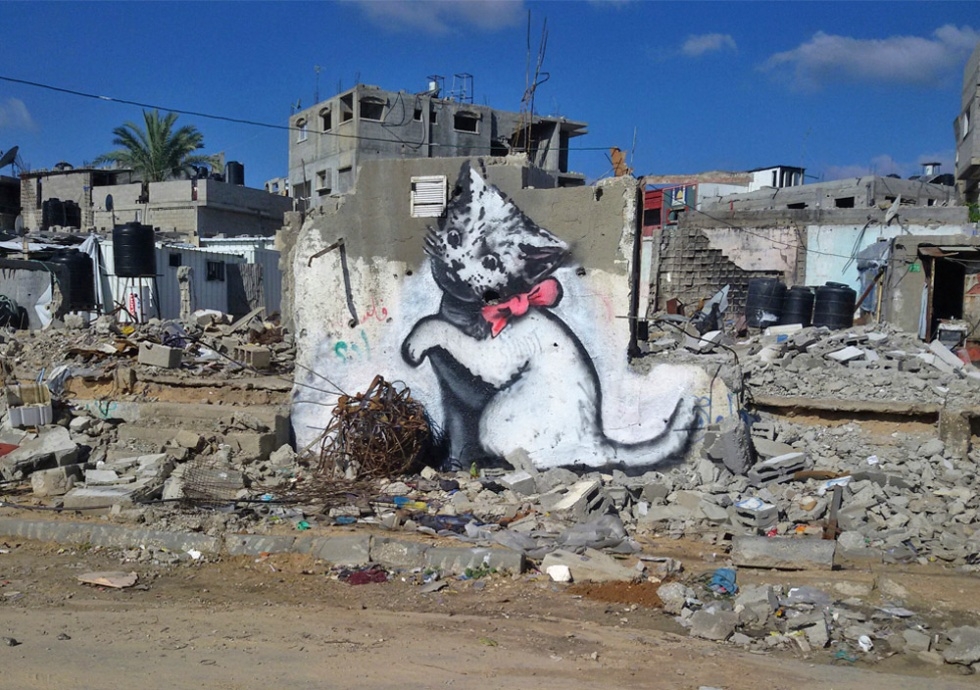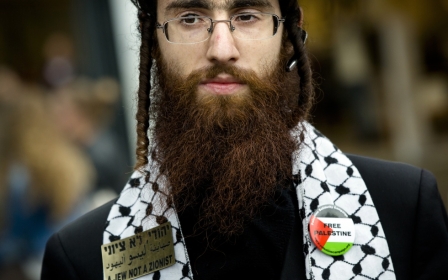Why did the Banksy cross the road?
Published date: Jeudi 12 mars 2015 - 10:41
|
Last update: 9 années 8 mois ago
Banksy tricks us with the cult of celebrity into believing he is the star attraction, when in reality it is actually Gaza

To get to the other side, of the wall of course. Everybody’s favourite elusive street artist returned on Thursday, in trademark cloak-and-dagger style, slipping in and out of Gaza and leaving behind an array of witty aesthetics. Banksy is no stranger to Palestine, having visited the West Bank twice before. So what motivates one of the world’s most successful artists to leave the comfort of success for the world’s largest open-air prison?
Long before Banksy’s former agent, savvy Steve Lazarides, helped usher Banksy in from the cold to the plush warmer surroundings of the auction house, before eBay bidding wars and bunfights for prints, before Sotheby’s and the fawning from art world glitterati, before Brad Pitt and Angelina Jolie, before stockbrokers became fans, before LA sell-out shows and the Oscar-nominated film, before it all, there was the street – Banksy’s preferred canvas.
For Banksy, the street is the ultimate gallery, democratic and accessible to all. The perfect space to disseminate hope, disquiet and ideas of change. Sharing stories by drawing pictures on walls is as old as humankind. Selling unattainable lifestyles on sectioned-off, sanitised billboards is not. Countering the commodification of space is a priority: Burberry wants you for your money; Banksy wants you for your brain.
Banksy’s interaction with space over the years has evolved into an enthralling ability to situate art with great poignancy. The environment became less canvas and more grand opportunity for exploration. Every crack, crevice, pipe, scrawl and imperfection blossomed into rich pickings for adaptation. In pursuit of subversive comment the environment took centre stage.
Intellectually engaging humour helped the public to swallow Banksy’s bitter pill. The people’s artist’s popularity grew and so did the value of his work; the ears of an affluent art-class were pricked, helping to monetise the brand. Banksy’s canvas, once limited to the small cityscape of the English city, Bristol, grew to encompass the entire globe. From New York to Mali Banksy left his mark. The people’s champion was crowned king of the world.
Banksy has struggled with the contradiction of being both proletarian rebel and bourgeois commodity. In response to an unofficial retrospective show held at London’s prestigious auction house Sotheby’s in 2014 Banksy said: “As a kid I always dreamed of growing up to be a character in Robin Hood. I never realised I’d end up playing one of the gold coins.”
For Banksy, “A wall is a very big weapon. It’s one of the nastiest things you can hit someone with.” Banksy is an artist in the Brechtian sense: his art is much more than just a mirror reflecting reality. The spray can becomes a hammer with which to shape and change the world, literally, by modifying the very landscape it defaces. Banksy manipulates an art industry fixated on value to fund projects that tackle bigger issues. The industry helps fund the movement: a good example of capitalism eating itself. Whether or not the master’s tools can be used to burn down his own house is a question for another day.
By 2007 Banksy’s prints had gone from struggling to sell on POW (Pictures On Walls, an online print shop he partly owns) for £50 to selling for thousands of pounds on eBay while the values of original pieces skyrocketed to the hundreds of thousands. Money drew new followers: bankers, professionals, collectors, investors and students looking to make a quick buck. Art was starting to play second fiddle; cash was king.
Banksy had a plan. Every Christmas, POW held an alternative art show called Santa's Ghetto in central London. The growing value of the work on show meant it had long lost its once niche appeal. Banksy had refused to raise the prices of his prints in order to make them affordable to fans. People would travel for miles to queue for a chance to obtain one and make a few thousand for one night sleeping rough.
After much suspense POW surprised Banksy’s fans, announcing that Santa's Ghetto 2007 would be held in Bethlehem that year. The only people who had a disposable income to book a flight at the last minute were the well off or paper chasers. But this ultimately was the point. Banksy, by way of bribery, removed the privileged from their bubbles of affluence and comfort, dropping them squarely into an apartheid war zone. West Banksy: the Pied Piper of occupation, bringing much needed wealth to Bethlehem’s dwindling tourist economy while simultaneously exposing fans and collectors alike to the harsh realities of checkpoints and oppressive towers of concrete. They flocked to Bethlehem taking away more than just the piece of paper they came for. Free with every print was an eye-opening experience they would never forget. Palestine would live with them for the rest of their lives, whether they liked it or not.
Banksy worked with local artist Tawiq Salsaa. Salsaa, who passed away in 2012, was an artist and master carpenter from Beit Sahour who famously subverted the nativity scene by inserting a wall separating the baby Jesus and the three wise men.
While under an Israeli-enforced curfew during Operation Defensive Shield in 2002, Salsaa carved a model of the Old City of Jerusalem from memory. Banksy bought the piece and with Salsaa’s blessing added watchtowers and gun-toting soldiers. The artwork was later gifted to the Bristol Museum and Tawiq was there for the unveiling. All money raised from the Bethlehem show went to fund children’s art projects in Palestine.
Propaganda and charity aside, Banksy’s greatest achievement was coaxing affluent profit chasers into physically and mentally experiencing the discomfort of towering walls and hostile soldiers. They met and spoke with real-life Palestinians, not caricatures formed in their imagination from bits of bad news.
Banksy is not without his flaws. He may have been a household name in the West but many Palestinians at that point had never heard of him. Even if they had, they might be forgiven for confusing his trademark rat for a form of insult. The truth was the opposite: Banksy’s rat is an ironic symbol of the Palestinians’ resistance. As Banksy put it: “If you feel dirty, insignificant or unloved, then rats are a good role model. They exist without permission, they have no respect for the hierarchy of society.” Still, to many a rat is still a rat.
Banksy seems to have learnt his lesson this time round; as far as I could see no rats were spotted in Gaza. What was also missing this time around, which was certainly more noticeable in his previous trips to Palestine, was a sense of hope. No peering into a better world through cracks prised open in the wall, no balloons for a little girl to float to safety. The tone of both his film and art lacked a lot of the usual cheekiness; it was, I thought, much more politically blunt. A reflection perhaps of the harsh reality of life on the ground, which leaves very little room for laughter.
Banksy calls for people to visit the besieged strip in a two-minute viral video summing up the bleak situation. Banksy once wrote: “Art should comfort the disturbed and disturb the comfortable.” This video and exhibition comfort the disturbed by disturbing the comfortable into, at the very least, thought and, at the very best, action. They make it clear that placid neutrality in the face of such barbarism is nothing less than tactical support.
The young Palestinian children who danced around the stencilled cat and the old man who interpreted its meaning are the real stars. Banksy’s art is a way of engaging us with our world, no matter how distant or far removed. For in a globalised world we are all connected. Banksy is in Gaza not for you to look at him but to acknowledge the reality of a manmade humanitarian disaster. Gaza as a bleak painting. Making this strikingly clear Banksy describes a conversation with a local man about the giant kitten stencilled onto what remains of a bombed house: “A local man came up and said, ‘Please – what does this mean?’ I explained I wanted to highlight the destruction in Gaza by posting photos on my website – but on the internet people only look at pictures of kittens.” Banksy tricks us with the cult of celebrity into believing he is the star attraction, when in reality it is actually Gaza.
- Charles B. Anthony is a writer, researcher and op-ed columnist specialising in social, political and cultural commentary.
The views expressed in this article belong to the author and do not necessarily reflect the editorial policy of Middle East Eye.
Photo: A graffiti by Banksy on a destroyed part of Beit Hanoun, a city north of the Gaza Strip (www.banksy.co.uk)
Middle East Eye propose une couverture et une analyse indépendantes et incomparables du Moyen-Orient, de l’Afrique du Nord et d’autres régions du monde. Pour en savoir plus sur la reprise de ce contenu et les frais qui s’appliquent, veuillez remplir ce formulaire [en anglais]. Pour en savoir plus sur MEE, cliquez ici [en anglais].





